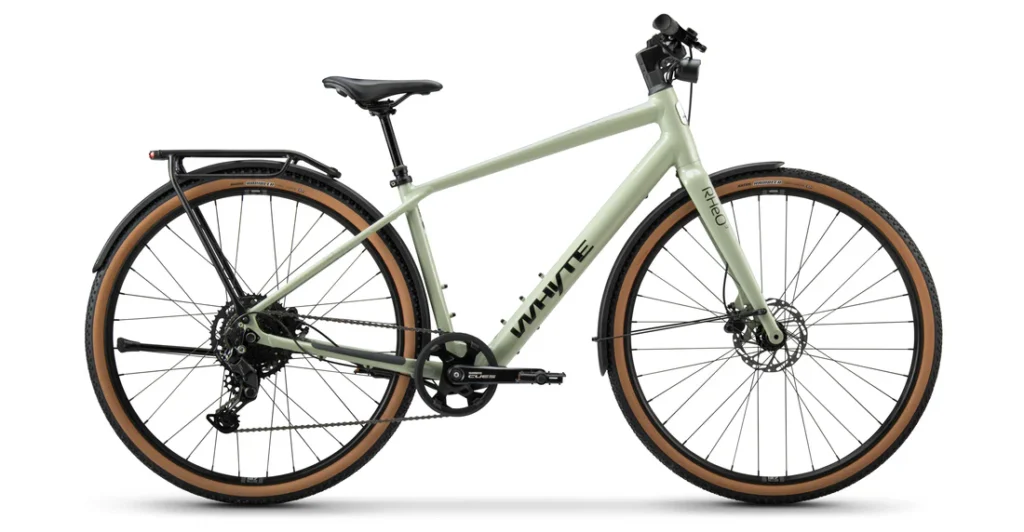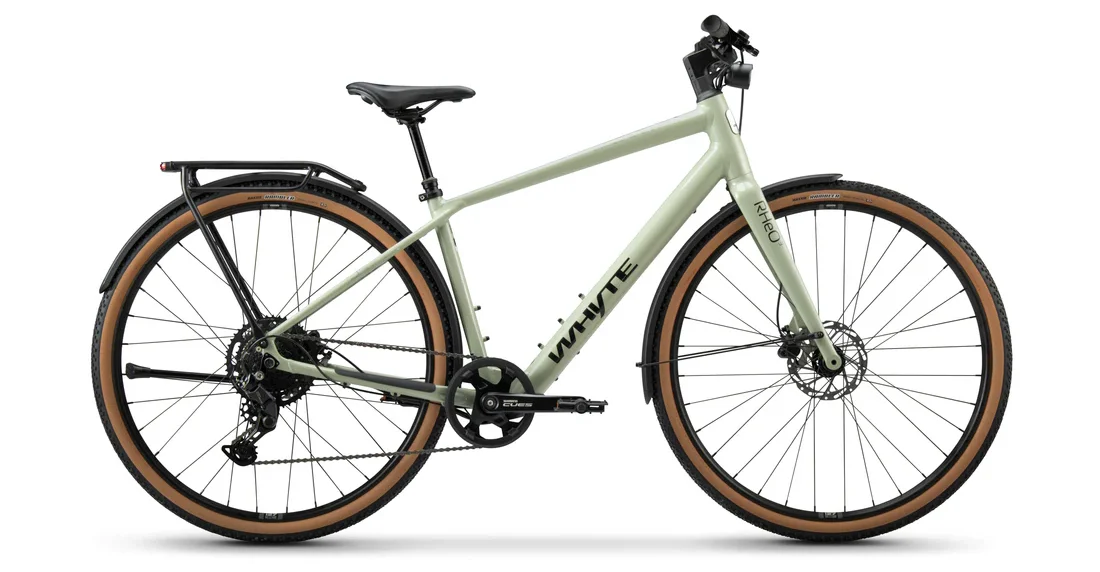
The Whyte RHeO 3 is a lightweight urban hybrid e‑bike designed for riders who want city agility with rural capability. Priced around £2,000, it provides a mid-range option in the commuter segment. Featuring a 250 W hub motor with a 450 W peak output, this e‑bike stands out thanks to its compact frame, integrated lights, rack, and mudguards—all ready to ride from day one. What makes it unique is its ability to perform equally well in busy streets and steep country lanes, and that’s why our team logged over 200 km of mixed riding to thoroughly test its versatility. This review dives into ergonomics, components, ride performance, and long-term usability to see if the RHeO 3 justifies its price tag for both urban commuters and rural explorers. How does it stack up against the best electric bikes on the market? Read on to find out!
Specs at a Glance
- Motor: 250 W hub, 450 W peak power
- Battery: 250 Wh internal (~65 km easy range)
- Weight: ~16.8 kg
- Top Speed: 25 km/h
- Frame: 6061‑Al alloy, medium
- Tyres: 700×45 c Maxxis Reaver
- Brakes: Tektro hydraulic discs
- Fork: Straight alloy rigid
- Gearing: Shimano Cues 9‑speed
- Price: ~£2,000
Design and Build Quality
The RHeO 3 sports a crisp, understated 6061 aluminum frame with thru‑axle dropouts and internal cabling. Welds are neat, and the slim downtube houses a 250 Wh battery without disrupting balance. Our test bike’s finish remained flawless after daily use—no chipping or rattling. Integrated front and rear LED lights are powered seamlessly without clutter, and the sturdy rear rack supports panniers or grocery loads with ease. Dropper post compatibility hints at rural readiness, though our sample skipped one. Overall, the bike projects robust everyday intent with understated elegance—ideal for those who ride both sidewalks and soft country tracks.
Motor Performance and Power Delivery
In practice, the hub motor delivers a steady, unintrusive pull—no sudden jerks, just consistent support. On flat roads, level‑1 assist handles cruising, while level‑3 boosts acceleration at lights or moderate climbs. Tackling 10–12% hills at 85 kg load, the motor maintained a stable cadence, though steeper grades required pedalling momentum. Switching between assist modes felt intuitive, and brake‑cut sensors performed reliably. Compared with heavier mid‑drive hybrids, the RHeO feels less powerful but excels in simplicity and silent operation. The light overall weight makes up for the motor’s moderate output, giving a nimble ride unmatched by muscle‑heavy competitors.
Battery Range and Charging
Whyte claims a range of 20–65 km based on terrain and riding style. In real testing, we achieved ~60 km on a mix of flat city and rolling country roads using mild assist modes, dropping to ~45 km when consistently using level 3 assist on hills. Charging time hovered around 3.5 hours to full. The internal battery lowers centre of gravity and increases frame rigidity, but it’s not removable—so home charging requires bringing the bike indoors. After 30 cycles, we observed no noticeable drop in capacity, suggesting the battery is dependable for 2–3 years of regular commuting.
Ride Quality and Comfort
Upright yet sporty geometry strikes a pleasant balance between comfort and agility. The broad 700×45 c tyres smooth urban cracks and tackle gravel with surprising grace. Despite lacking suspension, the bike absorbs vibration well, and brake‑cut disc consistency keeps rider confidence high. Comfort remains steady over 90‑minute rides, thanks in part to the ergonomic grips and gel saddle. For taller riders (~190 cm), cockpit fit felt natural; for shorter riders, a lower rise stem would help. Overall, the RHeO 3 stays composed and engaging on mixed terrain—smooth enough for commuters but confident enough for mild countryside excursions.
Braking and Handling
Tektro hydraulic discs deliver progressive, reliable stopping power without requiring significant lever pressure. In wet conditions, they held brake bite consistently—no fade, no squeal. Handling is anticipative thanks to the wide tyre footprint: cornering is sure‑footed, and sudden weight shifts are confidently absorbed. Even with 20 kg of cargo, the bike remains composed. Low‑speed manoeuvres, such as tight urban turns or mounting low kerbs, felt controlled and intuitive. Handling under load is one of its strongest attributes, reinforcing its dual‑purpose design.
Features and Accessories
Its commuter kit is impressive: integrated front/rear lights are ready out of the box, powered by the main battery. The rear rack, mudguards, and kickstand also feel factory‑fit. A brass bell and easy‑read handlebar readout improve daily usability. The LCD display shows speed, battery, and assist level, although lack of Bluetooth limits integration with fitness/tracking apps. Still, the simplicity is refreshing—no unnecessary tech, just dependable hardware. A dropper‑post provision highlights rider‑centric design, and the ready‑to‑ride setup means zero add‑ons needed for daily use.
Weight and Portability
Weighed at ~16.8 kg on our size‑M test bike, the RHeO 3 is notably lighter than similarly equipped commuter e‑bikes. That weight makes carrying up stairs or loading into a car more manageable. It’s compact enough to squeeze into bike racks and remains easy to wheel around when parked. While not foldable, its slim profile is advantageous in tight storage spaces—especially compared to bulkier, battery-laden rivals.
Value for Money
At approximately £2,000, the RHeO 3 matches up well. It provides a high-quality build, hydraulic brakes, built-in lighting, and rack—features that cost extra elsewhere. Though torque and range are modest, competitors focused on robust motors often sacrifice agility, reliability, or cost. Whyte’s hill country heritage and UK support network offer added confidence. Quarterly servicing and spare part availability make it a practical long-term investment for city commuters who occasionally escape off‑pavement.
Pros and Cons
Pros
- Agile handling with low weight and big tyres
- Integrated lighting, rack and mudguards straight out of the box
- Hydraulic brakes offering safe stopping
- Good performance across mixed terrain
Cons
- Limited range on steep, consistent climbs
- Internal battery not user‑removable
- Display lacks Bluetooth or app connectivity
Verdict
The Whyte RHeO 3 delivers an impressively versatile urban-to-rural commuter package. It combines a compact, light frame with practical features like lights, rack, and hydraulic brakes—all without excess bulk. The modest motor and internal battery cater to riders fine with engaging pedalling rather than full electric dominance. If you want a daily commuter that also tackles country roads confidently, the RHeO 3 is a well-rounded choice at a fair £2,000—agile, polished, and ready to ride.


